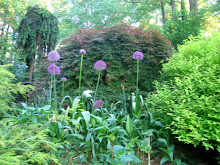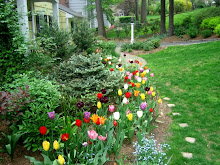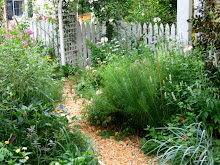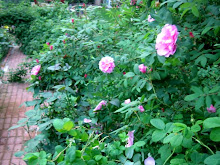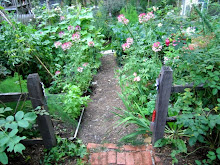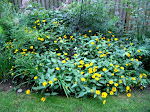 Gardening Gone Wild has started a Plant Pick of the Month where they invite garden bloggers to write about a specific plant. This month's pick is roses. I love roses. The comment I so frequently get is "It's so hard to grow roses." In my neighborhood, due to the misconception that the only roses which are easy to grow are carpet roses, that's all you see. In the garden centers, there too you see mostly carpet roses and the Knock Out roses. These are great roses, but what about the heirloom roses?
Gardening Gone Wild has started a Plant Pick of the Month where they invite garden bloggers to write about a specific plant. This month's pick is roses. I love roses. The comment I so frequently get is "It's so hard to grow roses." In my neighborhood, due to the misconception that the only roses which are easy to grow are carpet roses, that's all you see. In the garden centers, there too you see mostly carpet roses and the Knock Out roses. These are great roses, but what about the heirloom roses?
~
The old garden roses are so easy to grow. In most cases, you can dig a hole, add in some compost, plant the rose, water it well for the first year, and from there its requirements are the same as other shrubs in your garden. What they lack in remontancy is made up with fragrance and profusion of bloom. Also, if you grow the Portlands and Bourbons, you can have repeat blooming shrubs as well.
~
I cannot image my garden without the beauty, fragrance, reliability, and link to the past that old garden roses provide. I love them all, but here are six heirloom roses that are particularly wonderful.
~ 1. Rose de Rescht. Rose de Rescht (pictured) is a Portland rediscovered in the 1940s. It's small stature of three to four feet tall and wide makes de Rescht easy to mix into shrub or mixed borders. This rose is a deep pink with many petals and an amazing fragrance. Rose de Rescht, like others in the Portland class, blooms remontantly throughout the summer and fall. The foliage is plentiful and not prone to disease.
1. Rose de Rescht. Rose de Rescht (pictured) is a Portland rediscovered in the 1940s. It's small stature of three to four feet tall and wide makes de Rescht easy to mix into shrub or mixed borders. This rose is a deep pink with many petals and an amazing fragrance. Rose de Rescht, like others in the Portland class, blooms remontantly throughout the summer and fall. The foliage is plentiful and not prone to disease.
~
2. Paul Neyron. Paul Neyron is a Hybrid Perpetual rose from the mid-1800s. As a class, the Hybrid Perpetuals are not as easy to care for as the other classes of old roses. By the end of the summer, most to the shrub has been defoliated and affected by fungal disease, but I grow it anyway for the flowers. The flowers are quintessentially what you think of when you picture an old rose: fully double, extremely fragrant, a strong pink color with huge flowers six to seven inches across. Although the foliage leaves more be be desired, Paul Neyron's saving grace is also that unlike many Hybrid Perpetuals it is a reliable re-bloomer. I wouldn't be without it.
~ 3. Madame Plantier. Madame Plantier is the most forgiving and trouble free rose in my garden. My first Madame Plantier was planted in a shade garden seeing that it is a reliable bloomer even in shade. Unfortunately, the tree creating the shade fell down in a storm one late June morning. In preparation for the tree removal, I dug Madame up and unceremoniously plopped her in a black nursery pot. There she sat with no water, no fertilizing, no attention for two months on the kids' playground. Toward the end of August, seeing that Madame was still alive, I hastily dug a hole and planted her without amendments or special care. The rose survived and every June Madame Plantier graces the garden with a covering of fragrant, very double, white roses. I have three Madama Plantiers, one in the Rose Garden with full sun (pictured) and two others in a shady corner. All the plants grow equally well.
3. Madame Plantier. Madame Plantier is the most forgiving and trouble free rose in my garden. My first Madame Plantier was planted in a shade garden seeing that it is a reliable bloomer even in shade. Unfortunately, the tree creating the shade fell down in a storm one late June morning. In preparation for the tree removal, I dug Madame up and unceremoniously plopped her in a black nursery pot. There she sat with no water, no fertilizing, no attention for two months on the kids' playground. Toward the end of August, seeing that Madame was still alive, I hastily dug a hole and planted her without amendments or special care. The rose survived and every June Madame Plantier graces the garden with a covering of fragrant, very double, white roses. I have three Madama Plantiers, one in the Rose Garden with full sun (pictured) and two others in a shady corner. All the plants grow equally well.
~
4. Variegata di Bolgona. Variegata di Bolgona is a striped, once blooming Bourbon. This rose is beautiful. The striped old roses such as Rose Mundi, Leda, Camaieux, and Honorine de Brabant are incomparable to the modern stripes. I have also grown Fourth of July, a modern striped rose. Although Fourth of July is very healthy and a good bloomer, it's going to be removed in the spring because the garishness of the stripes are out of step with the restrained and classic beauty of the old roses which surround it. However, with the striped old roses, this is never an issue. They all blend beautifully with the other roses and plants growing around them. Variegata grows in the Long Border surrounded by sambucus, Japanese iris, veronicastrum, and false sunflower. Her flowers are lovely and the shrub is very healthy without any special treatment.
~ 5. Henry Martin. I love Henry Martin (pictured) because of his amazing color. It is one of the most richly colored Moss roses with petals that look like red velvet and the color and fragrance are rich and powerful.
5. Henry Martin. I love Henry Martin (pictured) because of his amazing color. It is one of the most richly colored Moss roses with petals that look like red velvet and the color and fragrance are rich and powerful.
~
6. Tuscany Superb. Every year I look forward to Tuscany Superb for the depth of color of its petals. This rose and many other Gallicas in my garden such as Charles de Mill, Complicata, the Apothocary Rose, Rose Mundi, Belle de Crecy, Camaieux, and Cardinal de Richelieu provide amazing color and fragrance to the rose season. Although they bloom only once, they bloom over three to four weeks and the bloom is so profuse that all the shrubs are covered with blossoms. What's more is the Gallicas, like most old roses, do not require elaborate fertilizing regiments or spraying. My rose garden currently has no irrigation and the Gallicas perform superbly and continue to look good throughout the summer.
~
Related Posts:
~
Creating the Rose Garden with a Central Brick Path
The Rose Garden in Spring and Summer: Daffodils replace the Lavender Border
How to Prune Roses, Part I: An Introduction
How to Prune Roses, Part II: Old Rose Pruning Secrets
How to Prune Roses, Part III: Why Prune?
Index of Rose Photos
Welcome to Heirloom Gardener
Saturday, November 29, 2008
Six Trouble-Free Heirloom Roses: Rose de Rescht, Paul Neyron, Madame Plantier, Variegata di Bolgona, Henry Martin, and Tuscany Superb
Posted by
Julia Erickson
at
5:36 PM
5
comments
![]()
![]()
Labels: Roses
Friday, November 28, 2008
Courtnay Daniels's 15 acres of gardens in Virginia
Sara Lin, in today's Wall Street Journal, writes: "Courtnay Daniels's backyard is testament to what a very avid gardener with considerable resources can create...In this bucolic area 20 miles west of Jefferson's Monticello, Ms. Daniels has devoted much of the last decade to 15 acres of gardens filled with rare and unusual trees, flowers, grasses and shrubs. There's a rose garden, a vegetable garden, a blue garden and an apricot garden. The orange garden is adjacent to the grass garden, and the yellow garden leads to the canal garden with its two reflecting pools. A five-acre arboretum boasts vast views of the surrounding hills." For the full article that also includes a slideshow, click here. The end of the slideshow includes a note that Ms. Daniels "gives tours of the gardens to about six groups a year."
Posted by
Julia Erickson
at
4:33 PM
0
comments
![]()
![]()
Labels: Botanical Gardens
Amaryllis, Winter Containers and Christmas Decorations

I haven't gotten around to the winter containers or Christmas decorations yet, but will be sure to post about them in the coming weeks. For those of you who have already moved on to those activities, here are two posts from last year that you may find helpful:
1. Container Gardening: Winter Containers
2. Christmas Decorations from the Garden
Posted by
Julia Erickson
at
1:20 PM
1 comments
![]()
![]()
Labels: Holidays
After the Frost: Thai Basil
Posted by
Julia Erickson
at
11:56 AM
1 comments
![]()
![]()
Labels: Heirloom and Organic Food
Thursday, November 27, 2008
Happy Thanksgiving: A Gardener's Thanksgiving Day Centerpiece
Today's centerpiece was harvested from my garden: broom corn; hickory and clethra leaves, previously soaked in glycerin and water; and Molina grass, for the binding.
~
~
I give thee thanks, O LORD, with my whole heart; before the gods I sing thy praise; I bow down toward thy holy temple and give thanks to thy name for thy steadfast love and thy faithfulness; for thou hast exalted above everything thy name and thy word. On the day I called, thou didst answer me, my strength of soul thou didst increase. All the kings of the earth shall praise thee, O LORD, for they have heard the words of thy mouth; and they shall sing of the ways of the LORD, for great is the glory of the LORD. -Psalm 138:1-5
Posted by
Julia Erickson
at
10:23 AM
2
comments
![]()
![]()
Labels: Cut and Forced Flowers, Holidays
Shrub Hibiscus Seed Heads in the Walled Garden
Posted by
Julia Erickson
at
6:00 AM
2
comments
![]()
![]()
Labels: Hibiscus, Seed Heads
Wednesday, November 26, 2008
Heritage Rose Hip in the Children's Garden
Posted by
Julia Erickson
at
6:00 AM
2
comments
![]()
![]()
Labels: Roses
Tuesday, November 25, 2008
After the Frost: Sunflower Seed Heads
Posted by
Julia Erickson
at
6:00 AM
2
comments
![]()
![]()
Labels: Seed Heads
Monday, November 24, 2008
Five Tips for Growing Edibles with Children

This month's Garden Bloggers' Design Workshop at Gardening Gone Wild is on Edibles in the Garden. While I am primarily a flower gardener, I do grow edibles in a dedicated vegetable plot, as well as in my mixed borders and containers. Given the size of my suburban lot, I cannot expect to grow enough to feed my family, but what I do grow is a lot of fun. Here are five tips for gardeners who want to attract those beneficials otherwise known as children.
~
~
 2. Grow vegetables that your children can plant, tend and/or harvest. This takes a little more effort on the part of mom than the former suggestion, but children can learn a lot from planting, tending and harvesting vegetables too. It's really amazing for a child to plant a seed or seedling, water it, watch it grow, tend it, and harvest it. This year, my children helped plant almost all of the vegetables and took particular pleasure in harvesting the asparagus, lettuce, eggplant, zucchini, tomatoes, cucumbers, corn and potatoes.
2. Grow vegetables that your children can plant, tend and/or harvest. This takes a little more effort on the part of mom than the former suggestion, but children can learn a lot from planting, tending and harvesting vegetables too. It's really amazing for a child to plant a seed or seedling, water it, watch it grow, tend it, and harvest it. This year, my children helped plant almost all of the vegetables and took particular pleasure in harvesting the asparagus, lettuce, eggplant, zucchini, tomatoes, cucumbers, corn and potatoes. 3. Grow heirloom varieties that you can't buy in the grocery store. As you can tell by the name of my blog, Heirloom Gardener, I am particularly interested in plants that our grandparents and prior generations grew. While these varieties aren't typically available as seedlings at your local nursery, you can buy an almost infinite variety through online and offline catalogs and seed exchanges. The children find the variety and novelty of them quite interesting. Some of my children's favorites this season were the lemon cucumbers (they are about the size and color of a prickly lemon) and the German stripe tomatoes (mostly yellow with a spot of orange on one end).
3. Grow heirloom varieties that you can't buy in the grocery store. As you can tell by the name of my blog, Heirloom Gardener, I am particularly interested in plants that our grandparents and prior generations grew. While these varieties aren't typically available as seedlings at your local nursery, you can buy an almost infinite variety through online and offline catalogs and seed exchanges. The children find the variety and novelty of them quite interesting. Some of my children's favorites this season were the lemon cucumbers (they are about the size and color of a prickly lemon) and the German stripe tomatoes (mostly yellow with a spot of orange on one end).~
 4. Grow edibles with which they can play. In addition to using some of the above vegetables for playing store, the children have also found other ways to play with the edibles. For example, they love using the hollow stems of chives and lovage as drinking straws. Also, they have made up a drink with the fresh mint, which is made of crushed mint leaves, sugar, and sparkling water.
4. Grow edibles with which they can play. In addition to using some of the above vegetables for playing store, the children have also found other ways to play with the edibles. For example, they love using the hollow stems of chives and lovage as drinking straws. Also, they have made up a drink with the fresh mint, which is made of crushed mint leaves, sugar, and sparkling water.~
 5. Grow flowers that are also edible. The children find it quite amusing that some flowers are edible. They particularly like including pansies, marigolds, calendula, and nasturtium flowers and leaves in our salads with mixed greens or as garnish.
5. Grow flowers that are also edible. The children find it quite amusing that some flowers are edible. They particularly like including pansies, marigolds, calendula, and nasturtium flowers and leaves in our salads with mixed greens or as garnish.~
Related posts:
- How to Build Raised Beds (on a Slope/Hill)
- Organically Preparing the Soil for Planting
- How to Make the Perfect Soil Mix for Seed Sowing
- Farmer's Almanac Spring Planting Schedule (May)
- Farmer's Almanac Spring Planting Schedule (April) and Heirloom Seed Sources
- How to Plant Corn the Way Squanto Taught the Pilgrims
- How to Plant Potatoes and Harvesting Asparagus
- My Eight Year Old Son's Great Potato Harvest
- Organic Beetle Control with Children
- Ten Tips for Planning a Children's Garden
- Creating the Children's Garden
Posted by
Julia Erickson
at
9:00 AM
5
comments
![]()
![]()
Labels: Garden Bloggers' Design Workshop, Gardening with Children, Heirloom and Organic Food
After the Frost: Brown Eyed Susan Seed Heads
Posted by
Julia Erickson
at
6:00 AM
2
comments
![]()
![]()
Labels: Seed Heads
Sunday, November 23, 2008
A Summer and Autumn Perennial: Metamorphosis of Cimifuga
Posted by
Julia Erickson
at
6:00 AM
1 comments
![]()
![]()
Labels: Seed Heads
Saturday, November 22, 2008
After the Frost: Star Magnolia in the Walled Garden
Posted by
Julia Erickson
at
8:02 PM
5
comments
![]()
![]()
Labels: Autumn Garden, Trees
Autumn Beauty: the Orange and Yellow Rose Hips of the Hybrid Musk Rose Penelope
Posted by
Julia Erickson
at
6:00 AM
2
comments
![]()
![]()
Labels: Roses
Friday, November 21, 2008
Autumn Beauty: Excellenz von Schubert
As a follow-up to my October Bloom Day post on roses, my roses were still blooming well into November. Last month, I somehow left out Excellence von Schubert, so here you go.
Posted by
Julia Erickson
at
8:35 PM
1 comments
![]()
![]()
Labels: Garden Bloggers' Bloom Day, Roses
Thursday, November 20, 2008
Autumn Beauty: the Fern Fronds change color too
Posted by
Julia Erickson
at
9:43 PM
4
comments
![]()
![]()
Labels: Autumn Garden
Tuesday, November 18, 2008
The Frost is Coming: It's Time to Cut All the Flowers

Posted by
Julia Erickson
at
10:12 PM
5
comments
![]()
![]()
Labels: Cut and Forced Flowers
A Late Season Bouquet in Tyra's Garden
I always take note of particularly inspiring arrangements and Tyra's of papavar seed heads, fig, ivy and more is a beautiful example of a bouquet without blooms. Check it out here:
http://waxholm.blogspot.com/2008/11/gardeners-wrap.html
Posted by
Julia Erickson
at
12:01 AM
0
comments
![]()
![]()
Labels: Cut and Forced Flowers, Gardening Blogs, Seed Heads
Monday, November 17, 2008
Saturday, November 15, 2008
Garden Bloggers' Bloom Day November 2008 - More Blooms Than I Ever Expected
Well, I still thankfully have yet to experience my first frost of the season, so my zone 6b garden has more blooms than I would normally expect for this time of year. Given my prior bloom days posts for September featuring dahlias and October featuring roses, I'm going to focus on other blooms--annuals, perennials and one flowering tree--though both dahlias and roses are also continuing to bloom. Check out what is blooming in other bloggers' gardens over at May Dreams Gardens.
~
 Autumn Cherry in the Walled Garden (more pictures and information here).
Autumn Cherry in the Walled Garden (more pictures and information here).  Petunia in a container in the Bird Garden.
Petunia in a container in the Bird Garden. Brown Eyed Susans continue to bloom from August until the frost in the Front Border. As a cut flower, it lasts for over a week in a vase.
Brown Eyed Susans continue to bloom from August until the frost in the Front Border. As a cut flower, it lasts for over a week in a vase. Japanese Anemone in the Front Border. The white was so bright it took me several attempts to get this picture.
Japanese Anemone in the Front Border. The white was so bright it took me several attempts to get this picture. Mexican Sunflower in the Children's Garden.
Mexican Sunflower in the Children's Garden. Verbena bonariensis in the raised vegetable beds in the Children's Garden.
Verbena bonariensis in the raised vegetable beds in the Children's Garden. Globe Thistle on Lilac Hill.
Globe Thistle on Lilac Hill. Mexican Bush Sage - Salvia leucantha outside the Children's Garden.
Mexican Bush Sage - Salvia leucantha outside the Children's Garden. Chrysanthemum on the edge of the Rose Garden.
Chrysanthemum on the edge of the Rose Garden. Nasturtium trailing from a container on the deck.
Nasturtium trailing from a container on the deck. Petunia in a container on the deck.
Petunia in a container on the deck. Salvia elegans in a large pot on the deck.
Salvia elegans in a large pot on the deck. Asclepias curassavica--annual Butterfly Weed--at the entrance to the Bird Garden.
Asclepias curassavica--annual Butterfly Weed--at the entrance to the Bird Garden. Salvia farinacea outside the Bird Garden.
Salvia farinacea outside the Bird Garden. Geranium 'Roxanne' is everywhere in the garden. It's one of the most useful edging plants I know. This one is in the Long Border.
Geranium 'Roxanne' is everywhere in the garden. It's one of the most useful edging plants I know. This one is in the Long Border.
Posted by
Julia Erickson
at
9:33 PM
4
comments
![]()
![]()
Labels: Annuals/Biennials and Perennials, Autumn Garden, Clematis, Garden Bloggers' Bloom Day
Search Heirloom Gardener
Labels
- About Blogging
- Annuals/Biennials and Perennials
- Autumn Garden
- Books and Movies
- Botanical Gardens
- Bulbs and Tubers
- Children's Garden
- Chrysanthemum
- Clematis
- Container Gardening
- Crocus tommasiniasus roseus
- Cut and Forced Flowers
- Cutting and Rose Gardens
- Dahlias
- Deep Thoughts About Gardening
- Egg Garden
- Fences Arbors Walls and Paths
- Floral arrangements
- Front Border
- Fun Stories About Gardening
- Garden Bloggers' Bloom Day
- Garden Bloggers' Design Workshop
- Garden Planning
- Gardening Blogs
- Gardening Tools and Structures
- Gardening with Children
- Goldberry Hill
- Heirloom and Organic Food
- Hibiscus
- Holidays
- Hydrangeas
- Japanese Beautyberry
- Lilies
- Mixed Borders
- New Jersey / Local Interest
- Nurseries
- Online Gardening Resources
- Peonies
- Pest Control
- Picture This Photo Contest
- Piet Oudolf
- Poppies
- Propagation and Seeds
- Pruning and Maintenance
- Roses
- Seed Heads
- Self Seeders
- Shrubs
- Spring Garden
- Summer Garden
- Trees
- Wildlife in the Garden
- Winter Garden
- Zinia
Blog Archive
-
▼
2008
(202)
-
▼
November
(39)
- Six Trouble-Free Heirloom Roses: Rose de Rescht, ...
- After the Frost: the Birch Tree
- Courtnay Daniels's 15 acres of gardens in Virginia
- Amaryllis, Winter Containers and Christmas Decorat...
- After the Frost: Thai Basil
- Happy Thanksgiving: A Gardener's Thanksgiving Day...
- Shrub Hibiscus Seed Heads in the Walled Garden
- CowPots™: Molded Manure - an idea to check out for...
- Heritage Rose Hip in the Children's Garden
- After the Frost: Sunflower Seed Heads
- Five Tips for Growing Edibles with Children
- After the Frost: Brown Eyed Susan Seed Heads
- A Summer and Autumn Perennial: Metamorphosis of C...
- After the Frost: Star Magnolia in the Walled Garden
- Autumn Beauty: the Orange and Yellow Rose Hips of...
- Autumn Beauty: Excellenz von Schubert
- Autumn Beauty: the Fern Fronds change color too
- The Frost is Coming: It's Time to Cut All the Flo...
- A Late Season Bouquet in Tyra's Garden
- Rosa virginiana hips
- Garden Bloggers' Bloom Day November 2008 - More Bl...
- "Put the Pruners Down and Step Away": Autumn is n...
- Autumn Beauty: The Last Clematis
- Sweet Brier Rose Hips
- Perhaps we garden bloggers can help remember our v...
- Autumn Beauty: Grasses in my Mixed Borders
- Autumn Beauty: Chrysanthemums
- How to Make a Planting Square to Uniformly Space Y...
- In Praise of Blotanical: Where Garden Blogs Bloom
- How to Grow Flowers on a Military Base in Iraq
- Interview with Lawrence Griffith, Colonial William...
- A Lattice Screen to Hide My Gardening Supplies and...
- Autumn Beauty: Clematis Seed Heads
- Autumn Beauty: The Yellow Leaves of the Hickory Tree
- One Garden That Still Looks Great After the Frost
- New Blogger Gadget: Followers
- Beyond Daffodils and Tulips: Seven Minor Bulbs To...
- Fragrance in the Garden: The Katsura Tree in Autumn
- A Flowering Tree for Spring and Fall: Autumn Cher...
-
▼
November
(39)












































